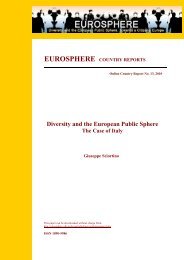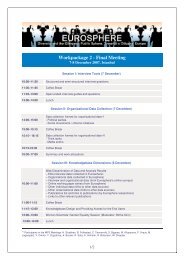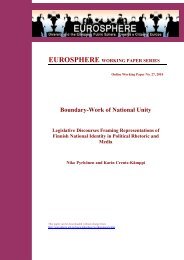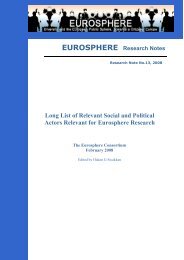Migrants, Minorities, Belongings and Citizenship. Glocalization and ...
Migrants, Minorities, Belongings and Citizenship. Glocalization and ...
Migrants, Minorities, Belongings and Citizenship. Glocalization and ...
You also want an ePaper? Increase the reach of your titles
YUMPU automatically turns print PDFs into web optimized ePapers that Google loves.
On the other h<strong>and</strong>, “participation in essentialized spaces versus glocal spaces” is also<br />
associated negatively with the dependent variable. This means that increased<br />
“participation in essentialized spaces” is associated with decreased “mobility of mind”,<br />
whereas increased “participation in glocal spaces” is associated with an increased<br />
mobility of mind. Therefore, the higher the degree of participation in glocal spaces, the<br />
higher the degree of mobility of mind.<br />
2.2.9. Alignments <strong>and</strong> misalignments in the public spaces<br />
Alignment/misalignment was measured along two major dimensions. The first dimension<br />
relates to how each channel or public space represents, articulates <strong>and</strong> voices<br />
respondents’ preferences about general policy issues – such as taxes, salaries,<br />
unemployment, human rights, welfare policies, security, relations with other countries,<br />
etc (a battery comprising 26 items). The second dimension is about how belonging issues<br />
are dealt with in different public spaces – issues such as freedom of belonging to a<br />
group, freedom of expressing different belongings, visibility of different belongings, etc (a<br />
battery comprising 22 items). The respondents were asked to rank the different public<br />
arenas with respect to how they experience these issues are dealt with in each public<br />
space. The two batteries were repeated for each of the four types of public spaces<br />
(numeric, corporate-plural, essentialized, <strong>and</strong> glocal).<br />
In the following analysis, the intermediate levels of analysis where we summarized these<br />
data are not reported. If it should be mentioned briefly, the summarizing analyses<br />
involved qualitative interpretation, quantification, <strong>and</strong> factorization. Analyzing <strong>and</strong><br />
interpreting each respondents’ responses to the respective questionnaire items, together<br />
with their statements during the in-depth interviews, we ranked<br />
alignments/misalignments between each respondent’s preferences <strong>and</strong> their perceptions<br />
of the structural/institutional capability of each public channel/space along a 5-point<br />
Likert scale. This resulted in eight summary variables – four measuring (mis)alignment<br />
concerning general policy issues <strong>and</strong> four measuring (mis)alignment concerning<br />
belonging policy issues. Table 12 illustrates the results from a CATPCA-procedure applied<br />
to these eight variables.<br />
86











